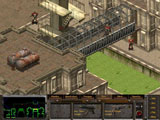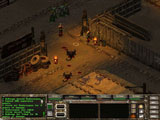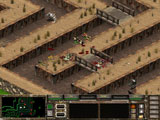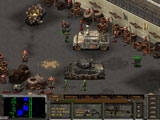 I love the future of past decades. The seventies’ future manifested itself in
silver jumpsuits, sleek, metallic rockets, and large hair à la various James Bond movies,
most notably Moonraker. The eighties
imagined day glow and floating skateboards. My
favorite future is from the 1950’s, when social engineering had a fascist edge and
didn’t bother to hide its onwards-and-upwards ideal of self-driving cars, homogenous
white suburbs, and bubble-n-plastic skyscrapers. That’s
why I like the post-apocalyptic-wasteland of Fallout, where the future of the fifties has
gone terribly, terribly wrong. And while
Fallout: Tactics is an impressive addition to the Fallout story, it disappoints in a few
minor but important ways. I love the future of past decades. The seventies’ future manifested itself in
silver jumpsuits, sleek, metallic rockets, and large hair à la various James Bond movies,
most notably Moonraker. The eighties
imagined day glow and floating skateboards. My
favorite future is from the 1950’s, when social engineering had a fascist edge and
didn’t bother to hide its onwards-and-upwards ideal of self-driving cars, homogenous
white suburbs, and bubble-n-plastic skyscrapers. That’s
why I like the post-apocalyptic-wasteland of Fallout, where the future of the fifties has
gone terribly, terribly wrong. And while
Fallout: Tactics is an impressive addition to the Fallout story, it disappoints in a few
minor but important ways.
 FOT
takes place between the years of Fallout 1 and 2 and follows a splinter faction of the
Brotherhood of Steel – a paramilitary organization believing it can save humanity
through technology – that has left California to search for the hub of a pre-war
vault network, which preserved parts of America after World War III, as well as escape
some of the more disturbing “racial purity” rhetoric of the group. These brave adventures set up shop near the ruins
of Chicago, and you are a new recruit. The
Brotherhood, in addition to finding the master vault, wants to fashion a new empire,
uniting the scattered remains of Illinois and Kansas in its velvet fist. Few have dreamed bigger. FOT
takes place between the years of Fallout 1 and 2 and follows a splinter faction of the
Brotherhood of Steel – a paramilitary organization believing it can save humanity
through technology – that has left California to search for the hub of a pre-war
vault network, which preserved parts of America after World War III, as well as escape
some of the more disturbing “racial purity” rhetoric of the group. These brave adventures set up shop near the ruins
of Chicago, and you are a new recruit. The
Brotherhood, in addition to finding the master vault, wants to fashion a new empire,
uniting the scattered remains of Illinois and Kansas in its velvet fist. Few have dreamed bigger.
As FOT is a tactical combat game built around a six-man team, it’s a departure
from the role-playing structure of previous Fallout titles.
It retains the rich character creation capabilities of earlier games with an
elaborate attribute, skill, and perk system, but the game itself operates in a series of
missions, playable only in a certain order. Also,
interacting with non-player characters is limited to set-piece speeches without dialogue
options.
 After
creating a character – deciding if he or she will be a sniper, hand-to-hand bruiser,
heavy weapons expert, thief, medic or some combination of the same – and filling out
your squad with other characters from the Brotherhood pool of recruits, you are turned
loose on the wasteland with the job of pounding anybody who happens to cross your path. The combat system is elaborate and full of
options, either allowing a high degree of customization or presenting a confusing array of
settings depending upon your outlook. Fallout
1 and 2 ran in real-time with combat working off of a top-down isometric view and
turn-based system similar to XCOM. FOT allows
you to do the same, with squad members and enemies allowed to move according to
initiative, or fight in a squad-based turn in which your entire squad acts followed by the
enemy, or in something called Continuous Turn Based.
CTB mimics real time with different actions – firing a weapon, going
prone – using action points that gradually renew themselves. Each type of play had different advantages and
disadvantages – Turn Based combat give a greater degree of individual control but
makes missions incredibly long; CTB makes the game run faster but turns your squad members
into more autonomous killers with sometimes unfortunate effects – and I like the
ability to move among each depending on the difficulty of various fights. After
creating a character – deciding if he or she will be a sniper, hand-to-hand bruiser,
heavy weapons expert, thief, medic or some combination of the same – and filling out
your squad with other characters from the Brotherhood pool of recruits, you are turned
loose on the wasteland with the job of pounding anybody who happens to cross your path. The combat system is elaborate and full of
options, either allowing a high degree of customization or presenting a confusing array of
settings depending upon your outlook. Fallout
1 and 2 ran in real-time with combat working off of a top-down isometric view and
turn-based system similar to XCOM. FOT allows
you to do the same, with squad members and enemies allowed to move according to
initiative, or fight in a squad-based turn in which your entire squad acts followed by the
enemy, or in something called Continuous Turn Based.
CTB mimics real time with different actions – firing a weapon, going
prone – using action points that gradually renew themselves. Each type of play had different advantages and
disadvantages – Turn Based combat give a greater degree of individual control but
makes missions incredibly long; CTB makes the game run faster but turns your squad members
into more autonomous killers with sometimes unfortunate effects – and I like the
ability to move among each depending on the difficulty of various fights. If this game had a fantasy setting, I’d say those fights
and the missions in general were dungeon crawls. Most
are set up on a maze-like map of crumbling buildings and bunkers in which you navigate
your team from one side to the other. While
some of the missions have a defend the fort or capture the flag-like objective, most of
the time you’re waltzing through a post-apocalyptic labyrinth with a few goals –
rescuing people or blowing something up – and not much in the way of puzzle-solving. Combat itself is tough and full of moving snipers
into position, sneaking machine gunners, observing patrol routines and planting mines,
but, really, each mission is a different maze with tougher opponents – escalating
from raiders, to beast lords, to mutants, to robots, etc.
Most mission-style games are like this, and FOT doesn’t innovate in
this area.
 here FOT does stand out is in sound. From the buzz of a mini-gun, the pop of a .45, or
the staccato chunks of an AK-47, FOT is full of great effects. The wind blows over blasted dunes and almost every
character is accompanied with excellent voice acting.
(The actor who plays Red Foreman, the dad on That 70’s Show, speaks as
one the Brotherhood generals.) The graphics
have changed in a few important ways from the Fallout 1 and 2, and while FOT ought to
stand on it’s own, I can’t help but compare the artwork of its progenitors. Here, FOT disappoints in that some of the bulky
50’s look of various characters and pieces of armor have been replaced with sleeker
versions. Super mutants look like puffed-up
bodybuilders instead of shambling menaces and deathclaws have becomes odd, devilish
things. I respect the impulse on the part of
the designers to remake FOT, but some of the distinctiveness of the Fallout universe have
been lost, as well as a great deal of the humor, resulting in a more generic
Roadwarriorishness. here FOT does stand out is in sound. From the buzz of a mini-gun, the pop of a .45, or
the staccato chunks of an AK-47, FOT is full of great effects. The wind blows over blasted dunes and almost every
character is accompanied with excellent voice acting.
(The actor who plays Red Foreman, the dad on That 70’s Show, speaks as
one the Brotherhood generals.) The graphics
have changed in a few important ways from the Fallout 1 and 2, and while FOT ought to
stand on it’s own, I can’t help but compare the artwork of its progenitors. Here, FOT disappoints in that some of the bulky
50’s look of various characters and pieces of armor have been replaced with sleeker
versions. Super mutants look like puffed-up
bodybuilders instead of shambling menaces and deathclaws have becomes odd, devilish
things. I respect the impulse on the part of
the designers to remake FOT, but some of the distinctiveness of the Fallout universe have
been lost, as well as a great deal of the humor, resulting in a more generic
Roadwarriorishness.
 Finally, the most troubling aspects of FOT are the bugs. Seemingly, all Fallout games are released and must
be followed with a patch to make them fully playable.
For many gamers, their copy of FOT had a corrupted third disk, which
wasn’t the fault of the developers but presaged the technical problems of the game
itself. FOT has some real crushers, and if
you don’t pay attention to the Fallout message boards, you might end up having to
restart the game several times at several different points. As of this writing, a patch is expected soon. Soon is a word everyone who buys a just-gone-gold
version of any games gets to know pretty well. I
contacted Microforte about the testing process, how debilitating bugs get by, but, as of
yet, have not heard back. Finally, the most troubling aspects of FOT are the bugs. Seemingly, all Fallout games are released and must
be followed with a patch to make them fully playable.
For many gamers, their copy of FOT had a corrupted third disk, which
wasn’t the fault of the developers but presaged the technical problems of the game
itself. FOT has some real crushers, and if
you don’t pay attention to the Fallout message boards, you might end up having to
restart the game several times at several different points. As of this writing, a patch is expected soon. Soon is a word everyone who buys a just-gone-gold
version of any games gets to know pretty well. I
contacted Microforte about the testing process, how debilitating bugs get by, but, as of
yet, have not heard back.
FOT is a good game and a fine
addition to the Fallout mythology. As a
successor to XCOM or a competitor with games like Jagged Alliance, I think it works well. Once the bugs are repaired, it’ll work even
better. However, the lack of innovation in
the genre, a hallmark of Fallout 1 and 2, some disappointing design decisions, and
playability issues preclude a perfect review. It’s
worth the time of anybody into squad-based tactics or fans of Fallout in general. Just wait for it to be fixed before purchase.
Matt Blackburn |
